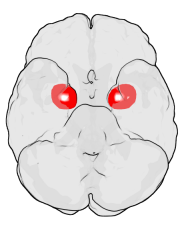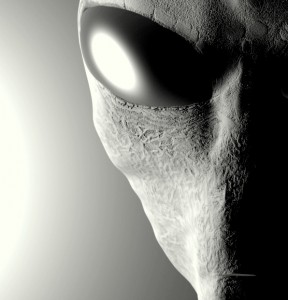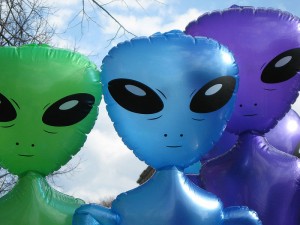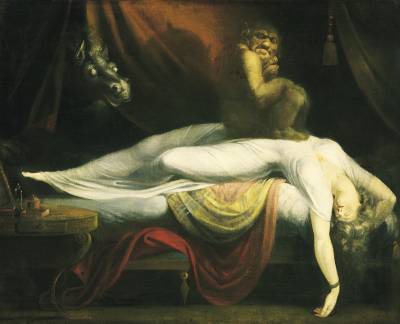This is how it happens for me: I’m completely asleep, and then something terrible creeps across the room, reaches spindly, pincer-like fingers for my hand, and pinches. That pinch is what wakes me up in terror, gasping and whimpering and trying desperately to pull my arm under the covers. But I can’t. I can’t do anything because no matter how I struggle, I can’t move a muscle. The light in the room is slanted so wrong it makes my skin crawl and all I can do is feel that thing hovering there, grinning horribly just beyond my field of view. I’ve tried to scream but my voice doesn’t work either. The only sound I’m capable of is a dog-pitched whine. The thing doesn’t leave until I lose consciousness.
I didn’t know this the first couple of times it happened, but my experience is by no means unique. It goes by many names, known variously as night terrors, the incubus, witches’ pressure and Old Hag syndrome. It happens when a few important wires get crossed in your brain and you accidentally wake up in the middle of dreaming. Old Hag syndrome is usually explained away as an evolutionary hiccup, a terrifying but harmless side effect of a mechanism that evolved to protect you. But the story might be a bit more complicated than that. In one case, those night terrors may have led to a series of deaths. Luckily, if you’re like me and the Old Hag plagues you, there are ways to fight her off.
The trouble manifests during waking sleep paralysis, which is a pretty common, anodyne experience that between 20 and 60 percent of people have experienced at least once. So let’s start with the obvious question: what causes it?
Waking sleep paralysis is a glitch where you wake up in the middle of REM sleep. During the REM phase — the part of the sleep cycle when you do your dreaming — your body and evolution have wisely conspired to paralyse you. Well played, evolution: Considering the crazy shit most of us get up to in our dreams, it was a good idea to equip our motor cortex with an off switch. Before this feature came standard-issue, several of our ancestors undoubtedly went off on lovely dream-fuelled midnight excursions that terminated in the stomach of a bear. But some people lack that paralysing inhibitory switch, and they do weird, crazy and tragic things in their sleep. One man strangled his wife as he slept.
So, okay, it’s pretty clear why we’re paralysed while we dream. But why do so many of us wake up in the middle? And worse, why does waking sleep paralysis so often come with a side order of Old Hag? Perhaps 40 percent experience the scary malevolent presence, says James Cheyne, a sleep researcher at the University of Waterloo in Canada.
According to Cheyne, susceptibility to the waking sleep paralysis glitch appears to involve a minor malfunction in the central hub of the brainstem, which coordinates sleep and REM. The malevolent feeling is explained by a different neural mechanism: REM sleep activates the neurons in the amygdala, an important area for processing emotion– especially fear– even as it reduces activity in the frontal lobes of the brain, which normally subdue the amygdala’s emo squalling.

So the chain of events becomes pretty clear. First, for most of us, the dreaming state is an emotional experience to begin with, during which we process the anxieties and fears we’ve been repressing all day. “This is likely why dreams in general tend to have more emotional content than waking experience and readily turn into frightening nightmares,” Cheyne explains. Then you wake up paralysed, which is just not going to prime you for happy thoughts. Compounding this is the fact that some of us are also waking up in the dark, alone. The imagery the brain concocts in this perfect-storm vulnerable state, Cheyne says, will originate from the fear-loving amygdala. And then, in a wretched feedback loop, that fear will activate the amygdala even more, generating fear that just feeds upon itself. It’s like lather-rinse-repeat: no wonder I end up crying in terror.
So the upshot is this: sleep paralysis is just a simple biological mistake that was never edited out during evolution because while the Old Hag is unpleasant, she has no deletrious effects on evolutionary fitness.
But hang on. It ends up being a little more complicated than that.
At nightterrors.org, a web site dedicated to helping people who suffer from these episodes, the first disclaimer is that “unlike what people have told you, this isn’t Satan.” If you’re not religious, that statement will strike you as a completely left-field nonsequitur. What does Satan have to do with any of this? And then it dawns on you that this little hiccup in the brain may have had an incredibly profound effect on human history. After all, an experience that intense, that has been shared by so many people across cultures, could account for a lot of humanity’s more inexplicable beliefs.
Throughout history, night terrors became associated with whatever “evil” memes were dominant in your culture. So during the middle ages, religious priming meant the malevolent presence was the incubus. Similarly, the Old Hag was a witch coming to steal your soul. Later, the experience was used as evidence for the existence of ghosts.
 But belief in ghosts and incubi isn’t what it used to be. Nowadays, people don’t readily reach for supernatural explanations when something horrible happens to them at night. Instead, after the ascent of science and technology in the 20th century torpedoed the ghost story, we found a new culprit: aliens. Susan Blackmore, a psychologist at the University of Plymouth, thinks the rise of alien abduction stories can be laid squarely at the feet of sleep paralysis episodes. It makes sense. The cultural soup in which we float informs how we interpret events that can’t be explained. You’ll believe the malevolent presence is whatever your culture says it is.
But belief in ghosts and incubi isn’t what it used to be. Nowadays, people don’t readily reach for supernatural explanations when something horrible happens to them at night. Instead, after the ascent of science and technology in the 20th century torpedoed the ghost story, we found a new culprit: aliens. Susan Blackmore, a psychologist at the University of Plymouth, thinks the rise of alien abduction stories can be laid squarely at the feet of sleep paralysis episodes. It makes sense. The cultural soup in which we float informs how we interpret events that can’t be explained. You’ll believe the malevolent presence is whatever your culture says it is.
Unfortunately, in at least one case, that belief may have been fatal. Reviewing Shelley Adler’s book Sleep Paralysis in The Atlantic, Alexis Madrigal reminds us that “what you believe interacts with how your body works.” Adler, a professor at the University of California, San Francisco, found a shockingly high rate of heart attacks among a culture called the Hmong. They were all men, and they all died in their sleep, at rates that equaled “the top five natural causes of death for other American men in their age group.” (Go read Madrigal’s recap. It’s riveting. Go on, I’ll be here when you get back.)
Turns out the Hmong had been culturally primed to understand night terrors as a creature that would end their lives, so it did.
If you were as horrified as I was to discover that it can actually get worse than feeling like something evil is coming to kill you– that it actually might succeed– you can take comfort in the fact that you have some options in your fight against the Old Hag.
Sleep researchers think the main culprit for night terrors is lifestyle: a combination of bad sleep schedule, sleep deprivaton, heavy alcohol intake, stress, and sleeping on your back will up your chances of hangin’ with the Hag. End your bad habits, they say, and the night terrors will depart with them.
However, if you’re like me, and the preceding list seems to have been lifted directly from your resume, you can get on an antidepressant: James Cheyne tells me that research subjects in his clinical practice who started medication that alters serotonin availability changed their sleep paralysis episodes.

If you prefer a slightly more DIY approach, try lucid dreaming. Psychologist Stephen LaBerge has written extensively on the transformative power of taking control of your dreams. Become the master of your sleeping life, and it stands to reason that you might be able to fight off the Old Hag no matter how much beer you’ve imbibed the night before. It seems pretty clear that there is a close connection between the two experiences. Lucid dreaming can often turn into sleep paralysis and sleep paralysis into lucid dreaming. In fact, lucid dreaming enthusiasts often use sleep paralysis episodes as an entry into lucid dreaming. I expected Cheyne to fall over laughing when I raised the topic, but he suprised me by calling the idea “interesting, but untested.” So now I have a copy of LaBerge’s book on my nightstand, waiting to take on the Old Hag. All I know about lucid dreaming is what I learned from Inception, which is that some dreamers start to think the dream is real. So if my next post is filled with ravings about the massive alien conspiracy, you’ll know what happened.
Image credits
The Nightmare by Johann Heinrich Füssli is in the public domain.
Amygdala: by wiki user Washington Irving

I experience this occasionally, so this post was revelatory: thank you; once you understand the physical chemistry, the Hag loses her illusory power. I have a few times used what I now recognise as ‘lucid dreaming’ to break out of it, in fact I remember I once took control and was starting to enjoy it when I woke up (properly).
Bedtime for me shortly… oooer… better have another glass of wine first …
Thanks, Tim. I’m wondering if I will remember all this when it happens again and I’m floating in the fear soup. Arguably, thinking rationally should be just as helpful as lucid dreaming. Then again, thinking rationally isn’t my forte in the dream state.
First time it happened to me, I was in a car (passenger seat, luckily).
In Louisiana folklore it’s called the cauchemar!
http://www.louisianafolklife.org/LT/Articles_Essays/main_misc_cauchemar.html
Regarding sudden death in the Hmong, it’s now know that many (all?) of those cases were what’s now known as Brugada syndrome, an genetic disorder that leads to abnormal heart rhythms and sudden death. Whether the attacks were triggered by night terrors is unknown (and maybe unknowable), but you probably don’t have to worry about dying from them unless you have Brugada!
I’m really curious. Are the night terrors you describe related to the ones that can strike children?
I had terrible night terrors as a child. These night terrors are different than the ones you describe–I’d sit up in the middle of the night screaming bloody murder, often screaming specific words, like “help!” My parents would rush to me, and discover that I wasn’t asleep, but wasn’t quite conscious. In the morning, I’d remember nothing.
Once, I spent the night at a friend’s house and the next morning her parents were fussing over me, asking me if I was ok. I had no idea what they were talking about. Turns out I’d had an episode. They told me I’d been screaming “Mommy!” I was mortified.
My mom tells me that these things are apparently somewhat common in kids. I think she even read something about it in Dr. Spock’s book.
Christie: A surprising number of people have emailed me with similar stories. “Night terrors” seems to be a specific phrase that is reserved, within the particular research community that studies the phenomenon, for children’s episodes. I didn’t find much research link early night terrors and the kinds of episodes I referred to in the post.
Joe: Thanks very much for that insight– definitely a relief. The Wiki on Brugada’s doesn’t mention whether SUDS deaths occur predominantly during sleep. Any chance you might have any further information about that?
Sally:
Yes, heart attacks in Brugada syndrome tend to happen at night, though I don’t think anyone has a good explanation for why. See Figure 6 in this paper for the data: Brugada patients sometimes get implants that monitor their heart and deliver a shock in the case of an attack, which allows measurement of the precise time of day, etc.
You’re describing Sleep Paralysis, not Night Terrors.
This is what night terror looks like (not exactly paralyzed, huh?: http://www.youtube.com/watch?feature=player_embedded&v=bSVwmSzxKtU#!
This is Sleep Paralysis: http://en.wikipedia.org/wiki/Sleep_paralysis
This is Night Terrors: http://en.wikipedia.org/wiki/Night_terror
Thanks for your note, Rob– I’ve had a few comments to this effect. I think the argument over the nomenclature points to an interesting gap in the language that’s been available to describe the phenomenon. All over the internet you’ll find people referring coloquially to their harrowing experience as “night terrors” and it’s pretty clear why: sleep paralysis sounds too anodyne to even hint at the deep terror that characterises the experience. Not only that, but “sleep paralysis” by itself does not terrorise. That is, not everyone who gets sleep paralysis gets the Old Hag feeling. James Cheyne, the sleep researcher I interviewed, said that “approximately 40%+ report a malevolent presence. A very small percentage report neutral or ambiguous presences.”
“Sleep paralysis,” then, fails to tell the whole story, both experientially and clinically. I think that’s what leads to the more widespread, even if inaccurate, use of the term “night terrors”.
I think the solution is to come up with a better all-purpose definition of the phenomenon. Any thoughts?
I suffer from sleep paralysis on a regular basis. It is extremely frightening even though I am now completely aware of what is happening (and have learned techniques to “break the spell” such as wiggling one digit -or whatever you can wiggle). However, in my many episodes I have never had the sensation of the presence of an evil spirit in the room. The terrifying feeling I experience is the sense that if I don’t wake up and I let myself fall back into sleep I will die or suffocate. Although it isn’t the same as feeling the presence of an evil spirit, it is absolutely terrifying when it happens.
I totally agree with Paul. I have experienced sleep paralysis for over 20 years (although now I take an SSRI that keeps it at bay.. except for when I miss a couple of days; then, without fail, it comes back). Earlier on, my sleep paralysis episodes definitely included the Old Hag experience… malevolent entities “trying to get me.” However, later, and through present day, when I experience sleep paralysis there is no hint of any form of an Old Hag, but the experience is still terrifying, nonetheless. There is definitely a sense of impending suffocation and utter helplessness. Almost like being buried alive.